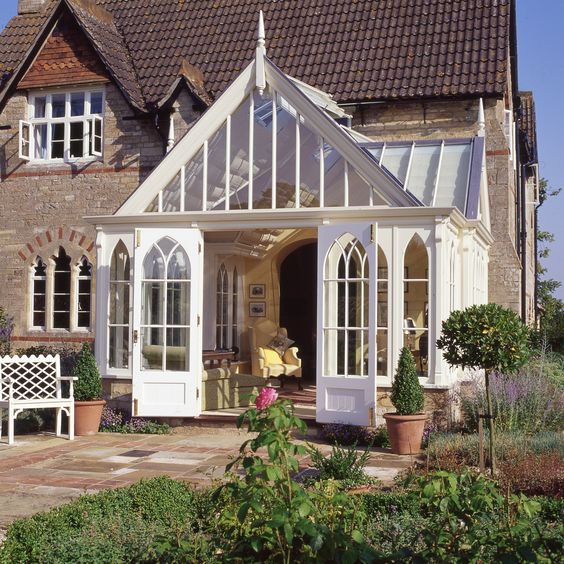
19 Feb ADVICE ON BUYING A CONSERVATORY
If you are planning to add a conservatory or sunroom to your property it is vital that you discuss the project fully with several conservatory companies to get as much advice as possible from them. Please bear in mind that every company will have a different approach to the project. How do you know which company is giving you the correct advice? You don’t! You will have to talk to each of them individually, take in their different opinions, look at their product, view some previous work undertaken by them, discuss the way the company undertook the work for the householder and then you will be able to make an informed decision.
With a conservatory, as you would expect, the roof would be the main feature. You can use either polycarbonate or glass in the roof. I prefer the glass option myself. Let me explain the features of both.
POLYCARBONATE – It is cheaper than glass, lighter and easier to handle for the builders. The builders can cut it to fit if the building is not built according to the correct base plan dimensions. The downside to polycarbonate is that it is very noisy when the rain falls on it. Some people have likened it to a child banging on a drum! It will expand and contract with the changes in temperature, causing cracking noises. It will also get dirtier than glass
GLASS – Glass roofs are sealed double glazed units (as in your windows) It gives the conservatory a richer feel to it. I would recommend that you use ‘K’ glass for all the glazing. ‘K’ glass is an insulated glass which will help reduce heat loss. These units can also be filled with argon gas which again will cut down on the heat loss. One side of the glass has a special metal coating, known as low emissive, or Low E. coating. This metal coating has virtually the same look as your ordinary double glazing but allows short-wave radiation, like sunlight through, but reflects long-wave radiation, such as heat from fires and radiators back into your conservatory making it easier to keep warm. As the Low E. coating on the glass actually makes the surface warmer to the touch, condensation is virtually eliminated.
ARGON GAS FILLING. Argon gas filled units combined with Pilkington “K” or Low E glass is the best option for glazing at the present time. The insulating properties are as good as, if not better than most brick / block built extensions!
The cost is nominal for the return gained from cutting down on the heat lost. It is well worth the extra few euros!
WHICH MATERIAL TO USE FOR THE FRAMES?
There are 3 types of materials. Pvc, hardwood and aluminium.
PVC is the choice for most conservatories built today. It has excellent insulating properties, is low maintenance and the cheaper option of the three. It comes in white, and various other coloured finishes. It is also available in light oak, dark oak and cherry woodgrain finishes.
HARDWOOD will give you an original looking finish but will require ongoing maintenance, varnishing, painting etc and will almost certainly be used where there are planning issues as in the case of listed buildings. Hardwood is more expensive than the other two.
ALUMINIUM Is a strong lightweight material but has not as good insulating properties as the other two. Aluminium is used mainly for commercial buildings etc. pvc cladded Aluminium is used in nearly all pvc conservatories for its structural properties.
You must decide whether you want your conservatory framework to sit on a dwarf wall or to be glazed to the ground. This is a matter of personal choice. It is a legal requirement that you will need to use Toughened safety glass if your glazing is below 800mm from the finished floor level.
You will want to consider where to site the conservatory. South facing will provide the best setting, making the most use of the sun. You may need to knock out an existing window or door to gain access to the conservatory. You will need some form of heating. You can use radiators joining onto the existing system. It is best to have your plumber or heating supplies company to work out the BTU’s required for the conservatory and when they suggest a size to you I would recommend that you purchase the next size up. It is always better to have too much heat than not enough. It is also advisable to use thermostatically controlled radiator valves as these can be turned up or down as required.
Underfloor heating is also a possibility. Again research is vital in this area.
You will need some electrical sockets and lighting. Why not add an outside light or even garden lighting while the electrician is on site. You might consider some blinds to cut down on the glare from the sun. If you really want to create an impression and your budget will allow it, why not go for the remote controlled blinds.
I like to see hardwood internal window boards used rather than pvc. and if you varnish them well (5-6 coats) lightly sanding in between coats, they really create an impression when you enter the conservatory.
A common problem when positioning the conservatory is the run of the existing sewers. You might find that you have an existing manhole right in the middle of the proposed conservatory floor. This problem can be overcome by the use of double sealed manhole lids or altering the position of the manhole. It is advisable to check with the local authority and get their advice / approval before moving the manhole. It is possible that the existing sewer drainage pipes attached to the house wall can be repositioned relatively easily to allow you to have a larger conservatory fitted.
A well designed conservatory of sufficient size will add extra usable space, look well and increase the value of your property. Don’t forget to advise your insurance company of this addition to the house.

Sorry, the comment form is closed at this time.